History of the rainbow Pride flag
The history of June being Pride Month
Every June, the LGBTQ+ community and allies celebrate what has become "Pride Month."
LOS ANGELES - The rainbow pride flag is a powerful symbol of LGBTQ+ pride and social movements. Since its inception, it has become a global icon of diversity, love, and acceptance. Understanding the history of this flag offers valuable insight into its significance and the progress of LGBTQ+ rights, especially as millions of people celebrate Pride Month in June.
The rainbow pride flag was created by artist and activist Gilbert Baker in 1978. Baker, a prominent figure in the gay rights movement, was commissioned by Harvey Milk, one of the first openly gay elected officials in the United States, to create a symbol of pride for the community.
The original flag had eight colors, each representing a different aspect of the LGBTQ+ community:
- Hot pink: Sex
- Red: Life
- Orange: Healing
- Yellow: Sunlight
- Green: Nature
- Turquoise: Magic/art
- Indigo: Serenity
- Violet: Spirit
Evolution of the flag
The flag has undergone several changes since its debut. The most notable alteration occurred in 1979 when the hot pink stripe was removed due to the unavailability of fabric in that color. Later, the turquoise stripe was removed, resulting in the current six-color version. This streamlined flag is the one most widely recognized today.
Symbolism and impact
The rainbow pride flag was created to symbolize diversity and the broad spectrum of human sexuality and gender. Each color reflects a different aspect of the LGBTQ+ experience, and the flag represents inclusivity and unity.
Here’s a short excerpt from Baker’s biography, "Rainbow Warrior," where he describes the moment during a night out with friends in 1978 when he was inspired to create the rainbow design:
"Everyone was there: North Beach beatniks and barrio zoots, the bored bikers in black leather, teenagers in the back row kissing. There were long-haired, lithe girls in belly-dance get-ups, pink-haired punks safety-pinned together, hippie suburbanites, movie stars so beautiful they left you dumbstruck, muscle gayboys with perfect mustaches, butch dykes in blue jeans, and fairies of all genders in thrift-store dresses. We rode the mirrored ball on glittering LSD and love power. Dance fused us, magical and cleansing. We were all in a swirl of color and light. It was like a rainbow. A rainbow. That’s the moment when I knew exactly what kind of flag I would make."

Artist Gilbert Baker poses by his pride flag at the 27th Annual Night Of A Thousand Gowns at the Hilton New York on April 6, 2013 in New York City.
According to the Museum of Modern Art in New York, Baker admired the rainbow's universality, calling it a "natural flag in the sky." Inspired by the American flag's use during the 1976 bicentennial, he designed the rainbow pride flag. While it has undergone revisions, all variations maintain the rainbow scheme.
The flag has been used in numerous LGBTQ+ rights marches, pride parades, and protests worldwide. It has become a powerful visual statement against discrimination and a symbol of solidarity within the community.
Global adoption and variations of the pride flag
Over the years, the rainbow pride flag has been adopted globally, with many variations emerging to reflect the unique experiences and identities within the LGBTQ+ community. A notable example is the Philadelphia pride flag, which includes black and brown stripes representing LGBTQ+ people of color.
The most updated version, the Progress Pride Flag, was designed by Daniel Quasar in 2018. This flag incorporates additional colors and design elements to represent a broader spectrum of the LGBTQ+ community, focusing on inclusivity and intersectionality.

In this aerial view, the Progress Pride flag is carried over the Sydney Harbour Bridge as people take part in Pride March on March 05, 2023 in Sydney, Australia.
The Progress Pride Flag retains the original six rainbow stripes but adds five new elements:
- White, pink, and light blue stripes: These stripes represent the transgender community and are drawn from the transgender pride flag.
- Brown and black stripes: Emphasize the importance of LGBTQ+ people of color and honor those lost to AIDS.
These new elements are arranged in a chevron pattern along the hoist side of the flag, pointing to the right to symbolize forward movement and progress. This design serves as a reminder that while significant strides have been made in LGBTQ+ rights, there is still much work to be done, particularly concerning marginalized groups within the community.
The Progress Pride Flag has been widely adopted and is celebrated for its inclusive approach. It reflects the evolving understanding of diversity within the LGBTQ+ movement and stands as a powerful symbol of unity, recognizing the intersections of race, gender, and sexual orientation in the ongoing fight for equality and justice.

